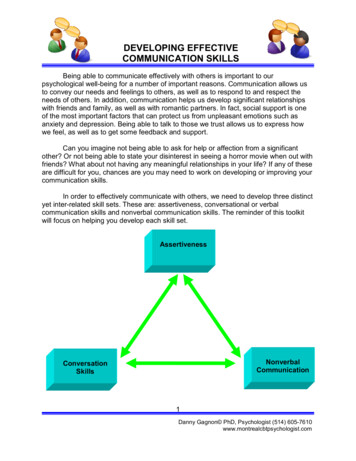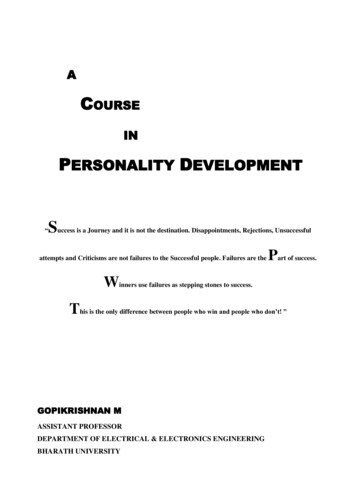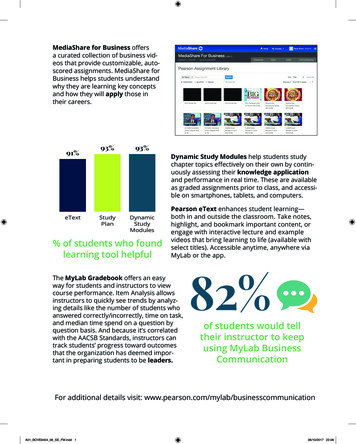
Transcription
DEVELOPING EFFECTIVECOMMUNICATION SKILLSBeing able to communicate effectively with others is important to ourpsychological well-being for a number of important reasons. Communication allows usto convey our needs and feelings to others, as well as to respond to and respect theneeds of others. In addition, communication helps us develop significant relationshipswith friends and family, as well as with romantic partners. In fact, social support is oneof the most important factors that can protect us from unpleasant emotions such asanxiety and depression. Being able to talk to those we trust allows us to express howwe feel, as well as to get some feedback and support.Can you imagine not being able to ask for help or affection from a significantother? Or not being able to state your disinterest in seeing a horror movie when out withfriends? What about not having any meaningful relationships in your life? If any of theseare difficult for you, chances are you may need to work on developing or improving yourcommunication skills.In order to effectively communicate with others, we need to develop three distinctyet inter-related skill sets. These are: assertiveness, conversational or verbalcommunication skills and nonverbal communication skills. The reminder of this toolkitwill focus on helping you develop each skill nSkills1Danny Gagnon PhD, Psychologist (514) 605-7610www.montrealcbtpsychologist.com
Hint: The goal of this toolkit is to help you develop general communicationskills. If you feel you need to develop your communication skills in specific domains,such as giving presentations, conflict resolution, interviewing, etc., make sure to pickup a book on the topic after reading this toolkit. Take a look at the RecommendedBooks section on my website for my recommendations.VALUABLE COMMUNICATION ATTITUDESBefore we move on to assessing and developing your communication skills, try tokeep these two attitudes that are worth developing in mind. These are: 1) beingproactive and; 2) thinking win/win (Covey, 1989).1. Being proactive: Being proactive means that you decide to take responsibility foryour life. In essence, you ‘take the bull by the horns’ or ‘captain your own ship’ andrefuse to let life ‘pass you by’. Thus, you choose to be happy, to achieve success, tobe happy, afraid and even to put this toolkit into action! Genetics, events, people andunfortunate circumstances take the back seat to your ability to choose and controlyour life. You ‘act’ and do not ‘react’! Remember that one of the only things thatcannot be taken away from you is your ability to choose! When interacting with otherpeople, create what you want by choosing to take responsibility and putting yourselfin the situation to achieve your goal. If you see a potential romantic partner, go talkto them. If you are interested in a new career, talk to someone in the field to get theiradvice. Remember that the alternative to being proactive is a life filled with regretand “I should have”.2. Thinking win/win: The society we live in tends to evaluate success in a bipolar waybecause much of what we are exposed to daily is based on competition. Forexample, during most sports there is a clear ‘winner’ and ‘loser’. In business, thegoal is to provide the best service or product to maximize profits and beat thecompetition. In essence, I succeed if I win and you lose, whereas I lose if you win.Thus, it is no small wonder why interpersonal interactions can also be seen as agame in which there is a clear ‘winner’ and ‘loser’.However, there is another way to approach relationships with other people.Thinking win/win is a more mature and confident way to approach humaninteractions. Rather than focusing on competition and winning at all costs, thisattitude seeks co-operation and mutual benefit so that both parties end upsucceeding, achieving their goal and being fulfilled as a result. When interacting withothers, try to keep this attitude in mind. Chances are you will get what you want if theother party feels they are as well.ASSERTIVENESS TRAININGIf you need to develop your assertiveness skills, use the toolkit on AssertivenessTraining that has already been developed. If you are unsure of whether assertiveness is2Danny Gagnon PhD, Psychologist (514) 605-7610www.montrealcbtpsychologist.com
a problem for you, complete the following self-assessment by answering thesequestions. If you answer yes to one or more of these questions, chances are you mayneed some assertiveness training. You are generally passive and keep quiet. You never or rarely state your opinionas well as what you want or need.You have difficulty saying “No.”You keep things bottled up inside you and eventually blow up.You find that the only way you can get what you need is by being aggressive.You feel that others take advantage of you or give you too much to do.You eventually give in to what others want.You feel that you are not respected by others.You have little or no self-respect because you do not communicate your needs,wants or opinions.Some people are afraid of being assertive because they hold certain myths aboutwhat it means to be assertive. Myths are not based on facts and as a result are not true.The following are common myths about assertiveness and how to go about challengingthem.Myth #1: Being assertive means being aggressive.This is false. When we are assertive, we do not raise our voice or shout at other people.Nor do we try to intimidate the other person by moving into their personal space or bybeing threatening. When assertive, the goal is not to convince others of our opinions orthat we are right at all costs. These behaviours are aggressive. When we actassertively, we speak with a normal tone, respect personal distance and state ouropinions, needs or wants.Myth #2: Being assertive means getting my way all the time.Not true. Assertiveness means expressing your opinions, wants or needs. Selfexpression does not mean that you are forcing others to agree with you. Rather,assertiveness means that you respect how others express themselves.Myth #3: If I am assertive other people will not like me. Being quiet means otherswill love me.Another myth that is not true. Being passive means you will simply follow what otherssay and do. There is no guarantee that others will like you more for this. In fact, somepeople who are passive eventually blow up at others because they can no longer take it.Will other people like you in this case? Some people also get irritated or annoyed atpeople who never state their opinion or what they want.Myth #4: Being assertive means being selfish.False. Expressing your opinions and needs is not selfish but a part of being human. Inaddition, assertiveness means that you respect others opinions and values even if youdisagree with them. Behaving with an assertive attitude means both giving andreceiving respect.3Danny Gagnon PhD, Psychologist (514) 605-7610www.montrealcbtpsychologist.com
Myth #5: I always have to say “Yes” and do what others want me to do.Not true again. Being assertive means communicating your boundaries and limits. If weare worried that others may think we are no good, lazy, uncaring, etc. because we say“No”, stating our limits is good for yourself and others as well. For example, stating weare overloaded with work and cannot take on another tasks will be beneficial to you andto the person delegating. Otherwise your quality of work may decrease or the task maynot get completed. In fact, we can’t expect others to know our limits, so we need tocommunicate them. Most people will be understanding once they know our boundaries.Myth #6: By being assertive I will always get what I want.This is a final untrue myth. Assertiveness does not guarantee we will get what we wantno matter how reasonable the request is or how nicely we ask. It means we express ouropinions, needs or wants and can respect ourselves as a result.NONVERBAL COMMUNICATIONAlthough we tend to think that communication is mostly verbal, what wecommunicate with our bodies, that is, our nonverbal communication, plays as big a role.In fact, there is much research suggesting that nonverbal communication can play aneven bigger role than what we say. Nonverbal communication involves where we look,the tone of our voice and even our body posture. Let’s use a quick example. Imagineyou are speaking to someone and they look disinterested. They will probably not lookyou in the eye, but rather look at the wall or clock and turn away from you. No matterhow interested they say they are, their nonverbal behaviour speaks otherwise.Nonverbal behaviour can communicate all sorts of messages to the other person,which is why we need to pay attention to it. For example: How you are feeling (e.g. scared, depressed or angry).Degree of interest.Knowledge of the specific subject matter being discussed.Your attitude (e.g. disgust, submissiveness).Honesty (i.e. are you hiding anything).How To Improve Your Nonverbal Communication Skills1. Perform a self-assessment. Use the following to help you identify potential problemareas.a. Tone and volume of voice: Do you have a low volume, can you be heard?Does your voice lack confidence? Does it sound shaky? Do you stutter? Speakquickly and not take regular breaths?b. Body movement: Do you keep your hands stiff by your side? Wave your handsuncontrollably? Keep your arms crossed all the time? Remain rigid? Do you nodoccasionally to let the other person know you understand them or are interested?c. Eye contact: Do you stare and not blink when looking at the other person? Doyou look away most of the time or stare at an object and not make eye contact?4Danny Gagnon PhD, Psychologist (514) 605-7610www.montrealcbtpsychologist.com
d. Body Posture: Do you slouch when you sit? Do you keep your head down?Turn and look at the person?e. Physical distance: Do you give the other person a comfortable amount ofpersonal distance (i.e. not too close or far)? Give space to a new person whojoins the conversation when in a group?f. Facial expression: Do you smile too much or not at all?2. Practice developing these skills.a. Don’t try to practice too many of these skills at once. Start with a few and moveon only when you have mastered them.b. If you feel comfortable, ask for a friend’s or relative’s help. Sometime we thinkthat we look uncomfortable or appear anxious etc. Get the feedback of a trustedperson to help you out if you can.c. If finding a friend is not possible, practice in front of a mirror. Although this mayfeel weird, you’ll get immediate feedback and you can practice as many times asnecessary without anything negative happening.d. If you have access to a video camera, record yourself. Watch the tape andpractice your problem areas.e. Once you have gained some confidence, practice these skills in the real world.Make sure to start off practicing with people with whom you would find it easier. Ifyou feel it would be easier with friends, choose them. If a teller or clerk might bebest, then go to a store and practice. To help you out, it might be useful to readthe toolkit on Exposure Therapy to help you out.Hint: We are not born with good social skills. Communication skills are notlike personality traits or innate abilities. They are skills that need to be developed bycontinual practice. So practice! practice! practice! as much as you can.CONVERSATION SKILLS1. Perform a self-assessment. Use the following to help you identify potential problemareas that you may want to work on. For example: Do you have trouble starting or keeping a conversation going?You don’t know what to say during a conversation?Is it hard to know what to say if the conversation becomes conflictual?Are you reluctant to talk about yourself?2. Practice developing your verbal skills.a. Starting a conversation. Make sure to introduce yourself first if you do not knowthe person. For example, make eye contact and say, “Hi. I don’t think we’ve met.My name is ”. Then move on to a topic that is general and that everyone can5Danny Gagnon PhD, Psychologist (514) 605-7610www.montrealcbtpsychologist.com
discuss. Examples include the weather, the news, make an observation (e.g. Ioverheard that you like sports) or give a compliment (e.g. That’s a nicenecklace). Make sure to pay attention to your nonverbal behaviour.Once the conversation is going well, you can move on to more personaltopics. For example, interests, political or religious beliefs, family or yourcareer.If someone else wants to join in, make sure to turn slightly towards them sothat you form a circle so that everyone can be a part of the conversation.b. How to keep a conversation going. Make sure you pause so that the otherperson can get a word in. Remember that a conversation is a two-way street. Pick a subject you have talked about and keep asking follow-up questions.For example, if the other person works as a physicist, ask them how they gotinto the field, what school they went to, what exactly they do, etc.Focus on the conversation and what the other person has to say rather than ifyou feel nervous or think your voice may be shaky. Concentrating on yourselfwill make talking harder, so focus on what the other person is saying.Don’t try to be witty or funny. Just go with the flow of the conversation.Hint: Take a moment and observe a conversation between two people. Youwill likely notice that the conversation alternates between self-disclosure and askingfollow-up questions.c. Keep the following ‘listening’ principles in mind (Burns, 1999). Disarming: If the discussion is getting a better heated or conflictual, findsome truth in what the other person has said even if you disagree, think theyare wrong or that it is unfair. Disarming will show you are listening, deescalate the situation and help you get back on track to the discussion.Thought or feeling empathy: Paraphrase what the other person is thinkingor feeling. For example, “So you think that the new reforms on healthcare aregood” or “You feel it was unfair when I showed up late.” This shows the otherperson that you are listening to them.Inquiring: If you are unsure of what the person means or is saying, simplyask a follow-up question to learn more. This will show the other person thatyou feel what they are saying is important.d. Keep the following ‘self-expression’ principles in mind (Burns, 1999). Use “I feel” statements: This is particularly true when conflict is involved.For example, “I feel upset when people don’t show up on time” or “I feel hurtwhen people yell.” Try to avoid using “you” statements, which is tough to do!6Danny Gagnon PhD, Psychologist (514) 605-7610www.montrealcbtpsychologist.com
For example, “I hate when you’re late” or “I hate when you yell at me.” “You”statements make others feel criticized and puts them on the defense, makingeffective communication unlikely.Stroking: Find something positive to say about the person to indicate thatyou value and respect them even if you are angry with them.e. Practicing with others. Make sure to practice your new conversation skills withfriends, family, strangers (e.g. salesperson in a store, someone in the elevator) orco-workers. If you find it useful, create a fear hierarchy using the toolkit onExposure Therapy to help you out. If you get comfortable, try breaking out of yourroutine by trying something new. For example, go up to a stranger andcompliment them, tell a friend about a personal weakness or give twocompliments each day. Remember that effective communication is a skill, sopractice will make perfect, or as close to perfect as possible!7Danny Gagnon PhD, Psychologist (514) 605-7610www.montrealcbtpsychologist.com
skills. If you feel you need to develop your communication skills in specific domains, such as giving presentations, conflict resolution, interviewing, etc., make sure to pick up a book on the topic after reading this toolkit. Take a look at the Recomm










